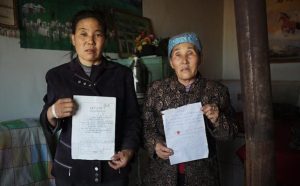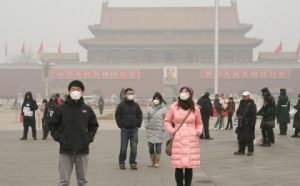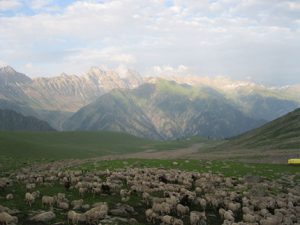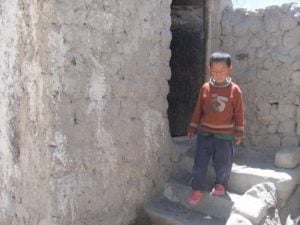For the Chinese environment, 2013 was a year of danger and crisis. The state of the environment continued to worsen, and this shows no sign of changing. The government did show determination: it issued an action plan on air pollution and the Third Plenum undertook to establish systems to manage the environment. But it will take stronger measures to arrest the decline, and so far no real start has been made on the key approaches to achieving this: openness, participation, and holding officials to account.
The environmental tragedy of the year occurred in November in Qingdao, when an oil pipeline exploded, killing or injuring over 100 people. An investigation found the pipeline was too close to urban drains, which points to failures in the environmental impact assessment (EIA) and planning processes. The pipeline should not have been built through a residential area, or the residential area should not have been built near an oil pipeline.
But it is common in China for EIAs to be faked and planning assessments to simply not exist – and so our country is littered with such ticking time-bombs.
We cannot assume that companies will sacrifice profits for the sake of the environment or public health, nor can we rely on certain government departments to do all they should. We must have another mechanism to avoid such errors, based on openness, participation and holding officials to account. If the location and associated risks of the pipeline in Qingdao had been known, and the public had been able to discuss the matter, perhaps a solution could have been found. With that and a strict system for ensuring officials are held responsible for their decisions, the disaster could have been avoided – and many lives saved.
But we still have a long way to go on openness and participation. Another important environmental case of 2013 was the opposition to a refinery in Anning, Yunnan, where locals complained of a lack of information and communication. Increasing numbers of environmental incidents make the public worried about the air, water and soil pollution caused by large factories – and also the risk of accidents such as that in Qingdao. Full openness and participation could reduce these concerns, but the government is not doing enough.
The public cannot participate
In June a second draft of a revision of the Environmental Protection Law was published for comment. The revision specified that the semi-official All-China Environmental Federation (ACEF) has the exclusive right to bring environmental litigation in the public interest – a rule that many opposed. A third draft published in late October did not mention the ACEF and appeared to widen the scope to other bodies but ruled that organisations bringing environmental litigation must be nationwide bodies registered with the civil affairs authorities, have been engaged in environmental protection for five consecutive years, and be of good repute.
Feng Yongfeng, founder of Green Beagle, explained that to be considered nationwide, a body must be registered with the Ministry of Civil Affairs. Add in the other requirements and only one body appears to be qualified – again, the ACEF.
This rule creates a huge obstacle to public participation in environmental protection.
But a more crucial failing than those mentioned above may be that officials are not brought to account for bad decisions they make. Take the heavy smog of 2013 as an example: air pollution was a problem nationwide this year, and if the population affected, geographical scope, length and toxicity of pollutants are taken into account,it may have been the world’s worst air pollution incident, with huge costs to health. And it was a man-made disaster, for which derelict officials have not yet been held to account.
Air pollution
In October a report from the WHO’s International Agency for Research on Cancer for the first time described air pollution as a common and significant environmental carcinogen. The report found evidence to show that exposure to outdoor air pollution can cause lung cancer and an increased risk of bladder cancer. Air pollution is now as much of a cancer risk as tobacco, UV radiation and asbestos.
The 2010 Global Burden of Disease report, published in 2012, showed that China suffered 1.24 million premature deaths in 2010 due to air pollution. Beijing’s health authorities have recently revealed that between 2002 and 2011 the incidence of lung cancer in the city rose form 39.56 cases per 10,000 residents to 60.09.
Air pollution has become a matter of genuine concern to the public, and is no longer just an environmental protection issue. It has become a quality of life problem, and even a diplomatic matter.
Although Ministry of Environmental Protection officials constantly proclaim to the media that China will not be following the Western path of polluting first and then cleaning up, the widespread smog shows that we are headed further and further along that very road. Why?
Air pollution is commonly blamed on industry, coal burning, vehicle emissions and even calm atmospheric conditions which prevent pollutants dispersing. But who is responsible for these uncontrolled emissions? Who is supplying poor quality fuel? Who is failing to supervise the polluters and enforce standards?
The central government has repeatedly ordered improvements and changes from industry, even at the cost of slower growth. But many local governments fail to combine planning for the environment and the economy – much less use this push to improve the local economic structure and promote green growth. Nor have personnel departments adopted central government wishes in their assessments of officials. From top to bottom it’s still a GDP-first approach, sacrificing the environment for economic growth. Behind the smog are local governments hell-bent on proving their worth through GDP increases.
But fault lies not just with local government. The central government bodies and large SOEs, with their industrial development plans, economic coordination, product supply and environmental assessments are more responsible. Look at Hebei, part of the circle of smog surrounding Beijing and an air pollution disaster zone. Hebei has long been China’s biggest steel producer – by 2008 it was producing 100 million tonnes a year. But this is mostly done by small, low-quality firms: 40% of production is from companies making less than six million tonnes a year. There is over-capacity, and these firms pollute heavily and are major contributors to smog in northern China.
How did all that low-quality manufacturing capacity come into being? Does the blame lie with local governments in search of GDP and steel firms with no social responsibility? What are the higher-up industrial and environmental authorities doing?
A failing MEP?
The Ministry of Environmental Protection (MEP) performance during this period of environmental degradation has not been stellar. China’s environmental problems may be the result of 30 years of distorted development, but it is in these most recent years that the degradation has been most apparent, and that shows the indolence of the MEP. A brief spurt of action over EIAs was abandoned in order to provide a “green channel” for 2008’s 4 trillion yuan stimulus program.
The ministry will itself know much of that over-capacity in Hebei’s steel industry dates back to that time. And in the last year or two the EIA process has not just failed to stop polluting and dangerous projects – the public have started to suspect the ministry and polluting firms are colluding. From Dalian and Qidong to Pengzhou and Kunming, the public have taken to the streets in protest. And now there are reports the MEP is to devolve the EIA process to its local bureaus – which might look like simpler and decentralised government, but will be seen as shirking of responsibility.
The MEP seems to have failed in its task to provide protection for the scientific view of development, much less paid attention to the public’s hopes. As China’s highest environmental protection body, the MEP is backed by central government policy and has public support – yet has always failed to get tough on supervision and enforcement.
Speaking at a Party meeting on the building of an ecological civilisation on May 24th, Xi Jinping called for indices representing such values – resource consumption, environmental damage, ecological benefits – to be included in systems for evaluating social and economic development; and for accountability systems for those who cause damage by failing to consider the environment – no matter how long ago those decisions were made.
For China, trying to get off that old road of polluting then cleaning up, a combination of openness, participation and accountability are the solution to managing the environment.







